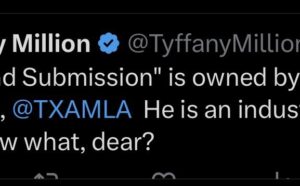In the heart of Washington, DC, in a generic-looking 11-story office building whose owners boast of its “high window ratio,” sits a 52-year-old tax-exempt organization named Morality in Media (MiM). It is perhaps the nation’s loudest voice against adult pornography. With a coalition that reads like a who’s who of conservative Christian organizations, the group is determined to get U.S. Department of Justice to enforce what it calls “existing federal obscenity laws” to crack down on “pornography and indecency.”
Their efforts have not been going very well.
Losing the War On Pornography
In 2001 and 2002, Morality in Media received more than $1.2 million annually in contributions. By 2011 and 2012, that number dropped by almost half; it took in just $641,318 and $832,934. The organization’s reported federal lobbying has declined from $80,000 in 2003, to $60,000 in 2004, to less than $20,000 in 2005. By 2006, it had terminated its federal lobbying registration entirely. The organization’s funding appears to be heavily from socially conservative foundations, including the Knights of Columbus (at least $250,000 since 2010), hedge fund millionaire Sean Fieler‘s Chiaroscuro Foundation ($50,000 in 2012), and billionaire Philip Anschutz’s Anschutz Foundation ($30,000 in 2012).
And while MiM still has enough sway to get politicians to take a stance — in a 2012 campaign effort to get presidential candidates on record saying they would crack down on “the distribution of illegal, hard-core and obscene pornography,” the organization yielded commitments from GOP candidates including Mitt Romney, Newt Gingrich, and Rick Santorum — it is impossible to know how sincere their pledges really were: Romney accepted multiple contributions from people involved in the pornography industry. One supporter and adult film producer told Yahoo! News that he did not “see any danger coming from Romney when it comes to porn. It’s just not there.”

The group still tries to stay relevant. Last month, when Attorney General Eric Holder announced he would soon leave the Department of Justice, MiM responded with glee. “For the last 6 years, we have worked to try to get him to enforce federal obscenity laws – and thus to help curb sexual exploitation,” it lamented, but Holder “refused and even disbanded the task force appointed to do such cases.” On its Facebook page, the group’s president wrote posted “The resignation of Attorney General Holder can only give hope to those suffering the ravages of the pornography pandemic in America. Holder was all that stood between that pandemic and its destruction.”
It is true that Holder’s Department of Justice has not made prosecuting adult pornography a priority, and it is unlikely that anyone President Barack Obama appoints will share MiM’s priorities. Regardless of who the next AG is, MiM and other anti-porn advocates are very likely to be disappointed. The reason is simple: they have, for all intents and purposes, already lost their war. While public opinion remains divided on the morality of porn, the forces that would use the power of government to criminalize it have seen their cause become underfunded, usurped, unpopular — and quite possibly unconstitutional.
An Unusual Coalition
In the 1970s and 1980s, the anti-pornography movement was in its heyday. While religious conservatives like Jerry Falwell and Phyllis Schlafly actively fought against what they considered to be immoral materials, their movement was aided by some strange ideological bedfellows: feminists.
The two groups did not always agree on what was and was not obscene — some feminists, like Gloria Steinem, drew a distinction between pornography and erotica that would not likely have been embraced by the Schlaflys of the world — but found common ground and pushed for the government to crack down on hard-core pornography.
Nadine Strossen, a professor at New York Law School and a former president of the American Civil Liberties Union, has long worked in defense of the First Amendment rights, in areas including adult pornography. In 1994 she authored a book entitled Defending Pornography: Free Speech, Sex, and the Fight for Women’s Rights. She told ThinkProgress that two women — Catharine MacKinnon and the late Andrea Dworkin — were the leaders of the “feminist anti-porn movement starting in late 1970s.” Their movement pushed to include anti-pornography laws in local civil rights ordinances in places like Minneapolis and Indianapolis. The laws were ultimately blocked on free speech grounds, which would put a major snag in the effort to push a legal crackdown. Still, Strossen says that this anti-pornography commitment was at the time “dominant among feminists and academics,” and that one “could count on one hand number of law professors speaking out on First Amendment grounds.”
Through the 1970s and 80s, the unexpected allies carried significant political punch. A commission recommendation calling for the legalization of adult obscenity was forcefully denounced by the U.S. Senate on a bipartisan 60 to 5 supermajority. Morality in Media’s then-president successfully pushed legislation in 1983 and 1984 to include pornographers under federal racketeering statutes. The 1984 Republican National Committee platform, for the first time, addressed the issue head-on: “We and the vast majority of Americans are repulsed by pornography. We will vigorously enforce constitutional laws to control obscene materials which degrade everyone, particularly women, and depict the exploitation of children. ” President Ronald Reagan, running on that platform, carried 49 states. And the newly re-elected president moved quickly to make good on that plank.
In 1986, President Ronald Reagan’s socially conservative attorney general Edwin Meese led the Commission on Pornography to examine the societal impacts of pornography and to find “effective ways in which the spread of pornography could be contained, consistent with constitutional guarantees.” The commission recommended a federal crackdown. MacKinnon praised the report, observing: “For the first time in history, women have succeeded in convincing a national governmental body of a truth women have long known: pornography harms women and children.” The then-president of Morality in Media celebrated the findings as the “death knell for the criminal pornographic industry” and predicted that if the Department of Justice implemented its “major recommendation for aggressive enforcement of existing obscenity laws,” all “hard-core pornography traffic” would be “brought to an end within two years.”
But that did not happen, at all.
Keep reading…








 TrafficHolder.com - Buy & Sell Adult Traffic
TrafficHolder.com - Buy & Sell Adult Traffic
[…] In 2001 and 2002, Morality in Media received more than $1.2 million annually in contributions. By 2011 and 2012, that number dropped by almost half; it took in just $641,318 and $832,934. The organization’s reported federal lobbying has declined from $80,000 in 2003, to $60,000 in 2004, to less than $20,000 in 2005. By 2006, it had terminated its federal lobbying registration entirely. The organization’s funding appears to be heavily from socially conservative foundations, including the Knights of Columbus (at least $250,000 since 2010), hedge fund millionaire Sean Fieler‘s Chiaroscuro Foundation ($50,000 in 2012), and billionaire Philip Anschutz’s Anschutz… Read more »
[…] This Is The Way The War On Pornography Ends […]